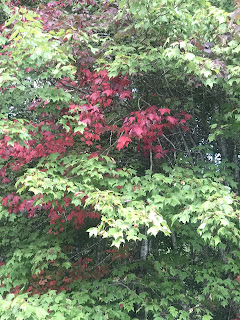I have been out in nature the past 10 days observing the signs of fall. I am using my senses when out in nature to be more observant and aware of my surroundings. I feel more presence in my life when I am observing and being a part of the nature around me.
I saw the light change in the past week or two from summer light to fall light? Have you noticed it?
I saw the change in the light. The light is lower in the sky, getting light later in the morning and getting dark earlier in the evening. The light comes through the trees lower and with a richer golden color.
I saw a few leaves change, like the red maple tree picture in this post as well as the blush of the dogwood starting. This is just the start of fall color change that usually does begin this time of year.
I saw acorns on the ground and walnuts falling out of walnut trees.
I saw fall wildflowers in full bloom with bees working the flowers for their honey.
I saw sunsets that made me tear up with joy over the blue mountains of the Appalachian range.
I heard the sound of leaves falling in the wind and the sound of falling walnuts and acorns.
I smelled, the rich balsam smell of fir trees in the forest as walked. I smelled the earthy smell of the deep soil of the forest floor covered in moss and lichens and ferns and mushrooms and fallen trees from many years past.
I felt the cold chill of early autumn air. And I felt the wind on my face, and the sun on my skin. I felt the soft floor of the forest floor, softened by many years of leaves and moss.
I tasted the air as I breathed it in. Amazing, clean, pure air. It tasted whole and like how air is meant to taste.
I was in Greyson Highlands State Park in Virginia and Roan Mountain State Park in Tennessee. I hiked on the AT in Virginia and Tennessee. A most beautiful fall is starting.
For those of you reading this, get outside and be present with nature observing with all of your senses. As you do, perhaps you can write down what you experienced.
If you would like to share, please share with me or a friend or family member.
I will make a point to write more frequently here. I will be outside daily making my phenology observations and sharing when I can.
Look back here for more info on my phenology project and what exactly is phenology. I will share where I record my observations and my phenology trail at Priddy Woods.
Here is a very interesting and education link to the USA National Phenology Network.
Until next time,
Becky Priddy
.











